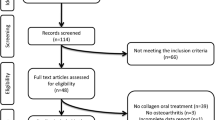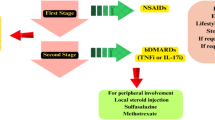Abstract
This double-blind, randomized controlled study was conducted with the aim to investigate the effect of magnetic field therapy applied to the hip region on clinical and functional status in ankylosing spondylitis (AS) patients. Patients with AS (n = 66) who were diagnosed according to modified New York criteria were enrolled in this study. Patients were randomly divided in two groups. Participants were randomly assigned to receive magnetic field therapy (2 Hz) (n = 35), or placebo magnetic field therapy (n = 31) each hip region for 20 min. Patients in each group were given heat pack and short-wave treatments applied to bilateral hip regions. Both groups had articular range of motion and stretching exercises and strengthening exercises for surrounding muscles for the hip region as well as breathing and postural exercises by the same physical therapist. These treatment protocols were continued for a total of 15 sessions (1 session per day), and patients were examined by the same physician at months 1, 3 and 6. Visual analogue scale (VAS) pain, VAS fatigue, Bath Ankylosing Spondylitis Disease Activity Index (BASDAI), Bath Ankylosing Spondylitis Functional Index (BASFI), Bath Ankylosing Spondylitis Metrologic Index (BASMI), DFI, Harris hip assessment index and Ankylosing Spondylitis Quality of Life scale (ASQOL) were obtained at the beginning of therapy and at month 1, month 3 and month 6 for each patient. There were no significant differences between groups in the VAS pain, VAS fatigue, morning stiffness, BASDAI, BASFI, BASMI, DFI, Harris hip assessment index and ASQoL at baseline, month 1, month 3 or month 6 (p > 0.05). Further randomized, double-blind controlled studies are needed in order to establish the evidence level for the efficacy of modalities with known analgesic and anti-inflammatory action such as magnetotherapy, particularly in rheumatic disorders associated with chronic pain.




Similar content being viewed by others
References
Sieper J, Braun J, Rudwaleit M, Boonen A, Zink A (2002) Ankylosing spondylitis: an overview. Ann Rheum Dis 61(Suppl3):iii8–iii18
Bodur H, Sivas F, Yilmaz O, Ozgocmen S, Gunaydin R, Kaya T et al (2011) Turkish league against rheumatism national recommendations for the management of ankylosing spondylitis. Turk J Rheumatol 26:173–186
Gran JT, Husby G (1998) Ankylosing spondylitis: prevalence and demography. In: Klippel JH, Dieppe PA (eds) Rheumatology, vol 6. Mosby, St Louis, pp 15.1–15.6
Khan MA (1994) Ankylosing spondylitis: clinical features. In: Klippel JH, Dieppe PA (eds) Rheumatology, vol 3. Mosby, St Louis, pp 25.1–25.10
Ibn Yacoub Y, Amine B, Laatiris A, Hajjaj-Hassouni N (2012) Gender and disease features in Moroccan patients with ankylosing spondylitis. Clin Rheumatol 31(2):293–297
Calin A, Elswood J (1988) The relationship between pelvic, spinal and hip involvement in ankylosing spondylitis: one disease process or several? Br J Rheumatol 27:393–395
Kobelt G, Andlin-Sobocki P, Maksymowych WP (2006) Costs and quality of life of patients with ankylosing spondylitis in Canada. J Rheumatol 33:289–295
Vander Cruyssen B, Vastesaeger N, Collantes-Estévez E (2013) Hip disease in ankylosing spondylitis. Curr Opin Rheumatol 25(4):448–454
Guan M, Wang J, Zhao L, Xiao J, Li Z, Shi Z (2013) Management of hip involvement in ankylosing spondylitis. Clin Rheumatol 32(8):1115–1120
Dagfinrud H, Kvien TK, Hagen KB (2008) Physiotherapy interventions for ankylosing spondylitis. Cochrane Database Syst Rev 23(1):CD002822
Gmitrov J, Ohkubo C, Okano H (2002) Effect of 0.25 T static magnetic fields on microcirculation in rabbits. Bioelectromagnetics 23(3):224–229
Weinberger A, Nyska A, Giler S (1996) Treatment of experimental inflammatory synovitis with continuous magnetic field. Isr J Med Sci 32(12):1197–1201
Markov MS (2007) Magnetic field therapy: a review. Electromagn Biol Med 26:1–23
van der Linden S, Valkenburg HA, Cats A (1984) Evaluation of diagnostic criteria for ankylosing spondylitis. A proposal for modification of the New York criteria. Arthritis Rheum 27(4):361–368
Jenkinson TR, Mallorie PA, Whitelock HC, Kennedy LG, Garrett SL, Calin A (1994) Defining spinal mobility in ankylosing spondylitis (AS). The Bath AS Metrology Index. J Rheumatol 21(9):1694–1698
Garrett SL, Jenkinson TR, Kennedy LG, Whitelock HC, Gaisford P, Calin A (1994) A new approach to deWning disease status in ankylosing spondylitis: the bath ankylosing spondylitis disease activity index. J Rheumatol 21:2286–2291
Calin A, Garrett S, Whitelock H et al (1994) A new approach to defining functional ability in ankylosing spondylitis: the development of the Bath Ankylosing Spondylitis Functional Index. J Rheumatol 21(12):2281–2285
Akkoc Y, Karatepe AG, Akar S, Kirazli Y, Akkoc N (2005) A Turkish version of the bath ankylosing spondylitis disease activity index: reliability and validity. Rheumatol Int 25(4):280–284
Ozer HT, Sarpel T, Gulek B, Alparslan ZN, Erken E (2005) The Turkish version of the Bath Ankylosing Spondylitis Functional Index: reliability and validity. Clin Rheumatol 24(2):123–128
MacKay K, Brophy S, Mack C, Doran M, Calin A (2000) The development and validation of a radiographic grading system for the hip in ankylosing spondylitis: the bath ankylosing spondylitis radiology hip index. J Rheumatol 27(12):2866–2872
Harris WH (1969) Traumatic arthritis of the hip after dislocation and acetabular fractures: treated by mould arthroplasty: an end-result study using a new method of result evaluation. J Bone Joint Surg Am 51-A:737
Doward LC, Spoorenberg A, Cook SA et al (2003) Development of the ASQoL: a quality of life instrument specific to ankylosing spondylitis. Ann Rheum Dis 62:20–26
Duruöz MT, Doward L, Turan Y, Cerrahoglu L, Yurtkuran M, Calis M, et al. (2013) Translation and validation of the Turkish version of the Ankylosing Spondylitis Quality of Life (ASQOL) questionnaire. Rheumatol Int Jun 14
Adey WR (2004) Potential therapeutic application of nonthermal electromagnetic fields: ensemble organization of cells in tissue as a factor in biological field sensing. In: Rosch PJ, Markov MS (eds) Bioelectromagnetic medicine. Marcel Dekker, New York, pp 1–12
Shupak N (2003) Therapeutic uses of pulsed magnetic-field exposure: a review. Radio Sci Bull 307:9–32
Braun J, van den Berg R, Baraliakos X, Boehm H, Burgos-Vargas R, Collantes-Estevez E et al (2011) 2010 update of the ASAS/EULAR recommendations for the management of ankylosing spondylitis. Ann Rheum Dis 70(6):896–904
Nienhuis RL, Hoekstra AJ (1984) Transcutaneous electronic nerve stimulation in ankylosing spondylitis. Arthritis Rheum 27(9):1074–1075
Dagfinrud H, Kvien TK, Hagen KB (2008) Physiotherapy interventions for ankylosing spondylitis. Cochrane Database Syst Rev 23(1):CD002822
Cheing GLY, Hui Chan CWY (2002) Does four weeks of TENS and/or isometric exercise produce cumulative reduction of osteoarthritic knee pain? Clin Rehabil 16(7):749–760
Conflict of interest
The authors declare that they have no conflict of interest.
Author information
Authors and Affiliations
Corresponding author
Rights and permissions
About this article
Cite this article
Turan, Y., Bayraktar, K., Kahvecioglu, F. et al. Is magnetotherapy applied to bilateral hips effective in Ankylosing spondylitis patients? A randomized, double-blind, controlled study. Rheumatol Int 34, 357–365 (2014). https://doi.org/10.1007/s00296-013-2941-7
Received:
Accepted:
Published:
Issue Date:
DOI: https://doi.org/10.1007/s00296-013-2941-7




